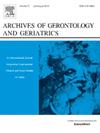Beyond the “European health divide”: Functional limitation disparities among older adults in Central and Eastern Europe
IF 3.8
3区 医学
Q2 GERIATRICS & GERONTOLOGY
引用次数: 0
Abstract
Objectives
Countries in Central and Eastern Europe (CEE) generally have worse health outcomes than the rest of Europe, commonly referred to as the “European health divide”. Regional specificities and historical pathways can shape health outcomes later in life, although variance of older adult functional limitation within CEE is understudied.
Methods
We used wave 9 (2021–2022) data (n = 18,903) from the Survey of Health, Ageing and Retirement in Europe (SHARE) with mixed effects regression models to analyze difficulty with mobility, near vision, hearing, and episodic memory among those ages 65+ in the Baltic States (Estonia; Latvia; Lithuania), Visegrád Group (Czechia; Hungary; Poland; Slovakia), Former Yugoslavia (Croatia; Slovenia), and the Black Sea (Bulgaria; Romania) while accounting for demographic, socioeconomic, health, and social tie indicators.
Results
Age-adjustments showed the highest difficulty rates of: mobility in Romania and Hungary, near vision in Latvia and Bulgaria, hearing in Estonia and Poland, and episodic memory in Poland and Croatia. Compared to the Baltic States, odds of reporting mobility difficulty were greater in the Black Sea but accounted for by socioeconomic factors. Fully adjusted odds of reporting near vision difficulty were lower in Visegrád Group and Former Yugoslavia. Fully adjusted odds of reporting hearing difficulty were lower in Visegrád Group, Former Yugoslavia, and the Black Sea. There were no regional differences in episodic memory.
Discussion
Functional limitation disparities, which were largely shaped by socioeconomic factors, varied throughout CEE. These findings highlight the heterogenous health and long-term care needs of older adults throughout CEE.
超越“欧洲健康鸿沟”:中欧和东欧老年人的功能限制差异
中欧和东欧(CEE)国家的健康状况通常比欧洲其他国家差,通常被称为“欧洲健康鸿沟”。区域特异性和历史途径可以影响晚年的健康结果,尽管中东欧老年人功能限制的差异尚未得到充分研究。方法我们使用来自欧洲健康、老龄化和退休调查(SHARE)的第9波(2021-2022)数据(n = 18,903),采用混合效应回归模型分析波罗的海国家65岁以上老年人的行动困难、近视力、听力和情景记忆。拉脱维亚;立陶宛),Visegrád组(捷克;匈牙利;波兰;斯洛伐克)、前南斯拉夫(克罗地亚;斯洛文尼亚)和黑海(保加利亚;罗马尼亚),同时考虑到人口、社会经济、健康和社会联系指标。结果年龄调整显示:罗马尼亚和匈牙利的行动困难率最高,拉脱维亚和保加利亚的视力困难率最高,爱沙尼亚和波兰的听力困难率最高,波兰和克罗地亚的情景记忆困难率最高。与波罗的海国家相比,报告行动困难的几率在黑海更大,但考虑到社会经济因素。完全调整后报告近视力困难的几率在Visegrád组和前南斯拉夫较低。完全调整后报告听力困难的几率在Visegrád组、前南斯拉夫和黑海较低。情景记忆没有区域差异。功能限制差异在很大程度上受社会经济因素的影响,在中东欧国家各不相同。这些发现突出了中东欧地区老年人健康和长期护理需求的异质性。
本文章由计算机程序翻译,如有差异,请以英文原文为准。
求助全文
约1分钟内获得全文
求助全文
来源期刊
CiteScore
7.30
自引率
5.00%
发文量
198
审稿时长
16 days
期刊介绍:
Archives of Gerontology and Geriatrics provides a medium for the publication of papers from the fields of experimental gerontology and clinical and social geriatrics. The principal aim of the journal is to facilitate the exchange of information between specialists in these three fields of gerontological research. Experimental papers dealing with the basic mechanisms of aging at molecular, cellular, tissue or organ levels will be published.
Clinical papers will be accepted if they provide sufficiently new information or are of fundamental importance for the knowledge of human aging. Purely descriptive clinical papers will be accepted only if the results permit further interpretation. Papers dealing with anti-aging pharmacological preparations in humans are welcome. Papers on the social aspects of geriatrics will be accepted if they are of general interest regarding the epidemiology of aging and the efficiency and working methods of the social organizations for the health care of the elderly.

 求助内容:
求助内容: 应助结果提醒方式:
应助结果提醒方式:


